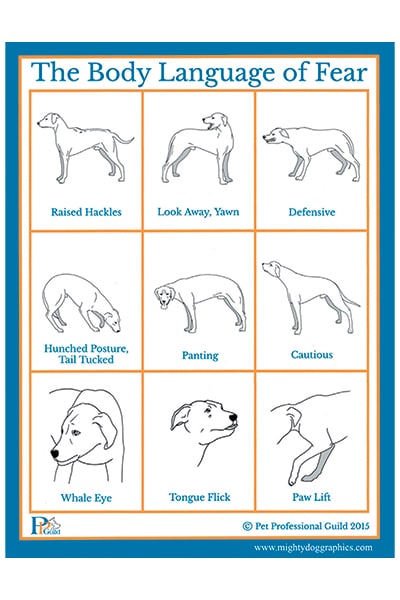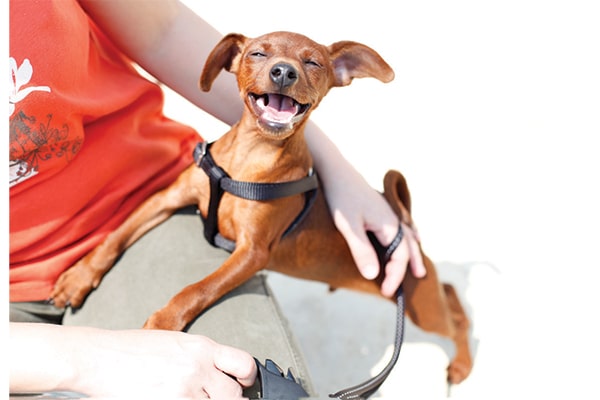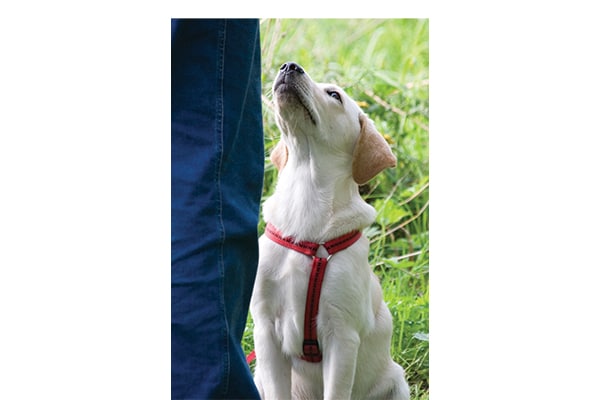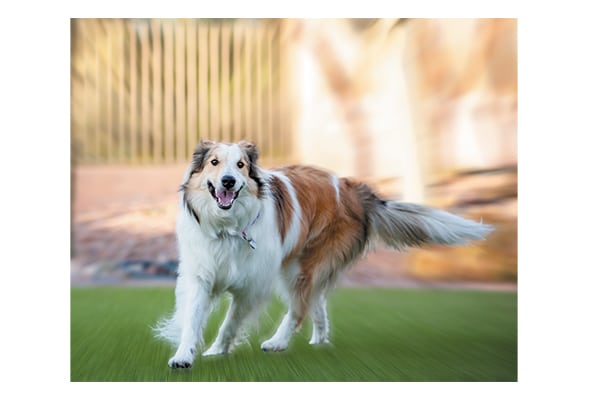Living with a fearful dog can be challenging for us, but imagine what it’s like for our dogs. Fearful dogs are often misunderstood because they may present with undesirable behaviors, often dubbed “bad behaviors,” such as being stubborn, running and hiding, barking, snarling, growling, lunging and even outright aggression. These misunderstood behavioral displays do not make a dog bad. These behaviors are most often a manifestation of fear or anxiety.
Left untreated, these behavioral displays can become habit or a way of being, leaving dogs unable to cope with the things they fear. Dogs are captive animals living in our human-dominated world. Although they have adapted quite well, they are not free from the stresses caused by living in a human environment.

What does fear look like?
Treating fearful dogs is a welfare issue, as well. Behavioral problems are the No. 1 reason that people relinquish their dogs to shelters. They don’t realize that fear is an emotion, not a behavior. Understanding the emotional state of dogs goes a long way to mitigating the massive numbers of dogs in shelters today.

The expression of fear ranges from obvious to extremely subtle. Look at these signs:
- rounded body
- tucked tail
- whale eye
- body and facial tension
- panting
- yawning
- ears back
- dilated pupils
- tongue flicking
If your dog is showing these signs of fear, it’s time to begin a treatment plan to help alleviate that fear. These dogs are not “bad,” they are merely expressing some level of stress. Becoming fluent in dog talk is key to understanding and helping a fearful dog become less fearful.

What causes fear?
Some dogs are afraid of other dogs or people, some lacked proper socialization as a puppy during the critical fear period the first 14 weeks of life, while others inherit fearful behaviors from their fearful mother or are genetically predisposed. Other dogs are afraid of different types of surfaces or doorways, noises, and yet others can become fearful because they were punished during training.
Another often overlooked cause of fear is unrecognized pain. Always get veterinary clearance before any kind of behavior modification is offered for a fear-related behavior.
A foundation of trust
We can help dogs feel safe by recognizing the signs of fear or anxiety and then becoming someone they trust. Trust happens when we create an environment that makes them feel safe. As dogs’ advocates and guardians, it’s our duty to be trustworthy.

Learning to see the world from a dog’s perspective helps us be that trusted person. They need a benevolent leader, one who is understanding, compassionate, kind, patient and fluent in dog. They need our undivided attention and know who we are before we can truly help a fearful dog.
Adopting a calm demeanor with a gentle, kind tone of voice, while reassuring and consoling them, allows them to assess and experience their world at their own pace. Fear is an emotion, and we can’t reinforce emotions, only behaviors.
Since fear is an emotion, not a behavior, we know that when dogs are in an emotional state of fear or anxiety, they are incapable of learning. They literally lose the ability to process information, therefore trying to train them while they’re afraid is impossible.
Think about this. If you are afraid of snakes, as I am, it would be impossible to concentrate with even just one snake slithering around you. You couldn’t think of anything else but how to get out of there as quickly as possible.
Dogs are no different. If they are afraid of other dogs and are on leash, unable to get away, even if the dog means no harm, they will not be able to relax until they are far enough away from the dog. At this point, and only at this point, will you be able to start a training program to help alleviate their fear of dogs. While in a state of flight or fight, no learning is possible.
How to help
The techniques we choose to help dogs move through their fears are desensitization or classical counter-conditioning. Never use flooding or punishment, or worse, ignore them, thinking they’ll just get over it. They won’t!
Desensitization is a technique whereby we gradually and systematically expose a dog to something that scares him, starting at a very low level, so we don’t incite the fear. Gradually, over time, we may increase the level of intensity, paying attention to the dog’s emotional state via his body language, keeping him comfortable before moving on to the next level. (Zoologist and Certified Applied Animal Behaviorist, Emeritus, Patricia McConnell, PhD, has a detailed book, The Cautious Canine, that explains this in even more detail.)
We all remember Pavlov’s dog, where the dog salivated every time he heard the bell, anticipating food. This is classical conditioning. We, too, can change the association from fear to comfort by using classical counter-conditioning. By pairing something that the dog is afraid of with something he loves — like his favorite food, toy or game — we can help him overcome his fears. This may take days, months or even years depending on the severity of his fear. The goal being that the dog has a positive emotional response to the fear because he knows that something good is going to happen.
For example, I have a dog who was traumatized in a car before I got him. He was brought to me in the back of a U-Haul truck, filled with household furniture, rattling around his crate in the dark with no food or water for two days straight. He wasn’t carsick, he was traumatized at the sight of a car. He began to shake uncontrollably, pant, whimper and drool all over himself and the car. I used a combination of desensitization and classical counter-conditioning to help him overcome his fear.

Using a high-value treat that I knew he loved (cut up pieces of hot dogs), I made a trail of treats, leading up to and around the car. I didn’t ask him to get in, only had him associate the car with food. Slowly over time, he walked around the car without needing food.
Next step, I opened the car door and got his favorite toy, a ball for fetching. We played fetch around the car. Over a few days of no anxiety around the car, I opened the door and threw pieces of hot dogs in the car. He jumped right in to get the treats. I didn’t do anything else. I let him jump out if he wanted to. I threw treats back in, and he got in three or four times. That’s all I asked for that day.
I repeated this for a few days and the next time, I shut the door and sat inside with him, feeding him treats. This went on for another few days. At every juncture, I paid attention to his body language, making sure there were no signs of fear. If so, we went back to the previous step until he was comfortable again, progressing on his terms.
I increased the amount of time in the car and then started the engine for one minute, increasing the time the engine ran, by minutes. When he was comfy, we backed up in the driveway a few feet and parked, calling it a day. The first trip we took was to a neighbor’s home with his favorite playdate, two doors down. Gradually, over time, we could drive to town, go to a park, play fetch and come home.
Helping a fearful dog requires kindness, patience, consistency, trust and knowledge. The journey we take with our fearful dogs can be the most humbling and gratifying experiences of our lives while dramatically deepening the human-dog bond.
Finding the Right Trainer

When searching for the right fit for you and your fearful dog, look for someone who:
- uses positive rewards
- has science-based training
- is fluent in dog speak
- specializes in fearful dogs
This type of trainer will have the experience and knowledge to help you help your dog. A veterinary behaviorist (not a general practice veterinarian) is also a great choice. Although this can be on the more expensive side, it’s worth it if you can’t find an experienced and knowledgeable trainer. In the United States, at this time, dog training is still an unregulated field, although we do have excellent professional organizations and certifications available to trainers. The law does not require dog trainers to follow only training techniques that don’t cause harm to dogs, so do your research.
Learn more about fear and anxiety in dogs at dogster.com:
- Have a Fearful Dog? Keep These 6 Things in Mind
- 7 Means of Dog Anxiety Treatment
- What Are Dogs Scared Of? How to Help Dogs Overcome Their Fears
Featured Photo Credit: Victoria Rak | Tuff Photo









